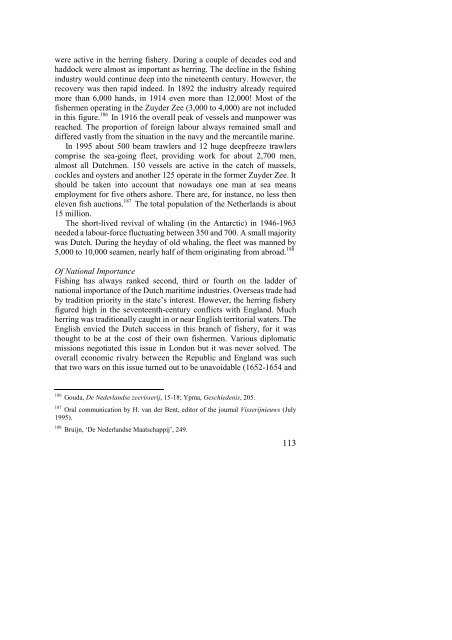The North Atlantic Fisheries, 1100-1976 - University of Hull
The North Atlantic Fisheries, 1100-1976 - University of Hull
The North Atlantic Fisheries, 1100-1976 - University of Hull
Create successful ePaper yourself
Turn your PDF publications into a flip-book with our unique Google optimized e-Paper software.
were active in the herring fishery. During a couple <strong>of</strong> decades cod and<br />
haddock were almost as important as herring. <strong>The</strong> decline in the fishing<br />
industry would continue deep into the nineteenth century. However, the<br />
recovery was then rapid indeed. In 1892 the industry already required<br />
more than 6,000 hands, in 1914 even more than 12,000! Most <strong>of</strong> the<br />
fishermen operating in the Zuyder Zee (3,000 to 4,000) are not included<br />
in this figure. 186 In 1916 the overall peak <strong>of</strong> vessels and manpower was<br />
reached. <strong>The</strong> proportion <strong>of</strong> foreign labour always remained small and<br />
differed vastly from the situation in the navy and the mercantile marine.<br />
In 1995 about 500 beam trawlers and 12 huge deepfreeze trawlers<br />
comprise the sea-going fleet, providing work for about 2,700 men,<br />
almost all Dutchmen. 150 vessels are active in the catch <strong>of</strong> mussels,<br />
cockles and oysters and another 125 operate in the former Zuyder Zee. It<br />
should be taken into account that nowadays one man at sea means<br />
employment for five others ashore. <strong>The</strong>re are, for instance, no less then<br />
eleven fish auctions. 187 <strong>The</strong> total population <strong>of</strong> the Netherlands is about<br />
15 million.<br />
<strong>The</strong> short-lived revival <strong>of</strong> whaling (in the Antarctic) in 1946-1963<br />
needed a labour-force fluctuating between 350 and 700. A small majority<br />
was Dutch. During the heyday <strong>of</strong> old whaling, the fleet was manned by<br />
5,000 to 10,000 seamen, nearly half <strong>of</strong> them originating from abroad. 188<br />
Of National Importance<br />
Fishing has always ranked second, third or fourth on the ladder <strong>of</strong><br />
national importance <strong>of</strong> the Dutch maritime industries. Overseas trade had<br />
by tradition priority in the state’s interest. However, the herring fishery<br />
figured high in the seventeenth-century conflicts with England. Much<br />
herring was traditionally caught in or near English territorial waters. <strong>The</strong><br />
English envied the Dutch success in this branch <strong>of</strong> fishery, for it was<br />
thought to be at the cost <strong>of</strong> their own fishermen. Various diplomatic<br />
missions negotiated this issue in London but it was never solved. <strong>The</strong><br />
overall economic rivalry between the Republic and England was such<br />
that two wars on this issue turned out to be unavoidable (1652-1654 and<br />
186 Gouda, De Nederlandse zeevisserij, 15-18; Ypma, Geschiedenis, 205.<br />
187 Oral communication by H. van der Bent, editor <strong>of</strong> the journal Visserijnieuws (July<br />
1995).<br />
188 Bruijn, ‘De Nederlandse Maatschappij’, 249.<br />
113















